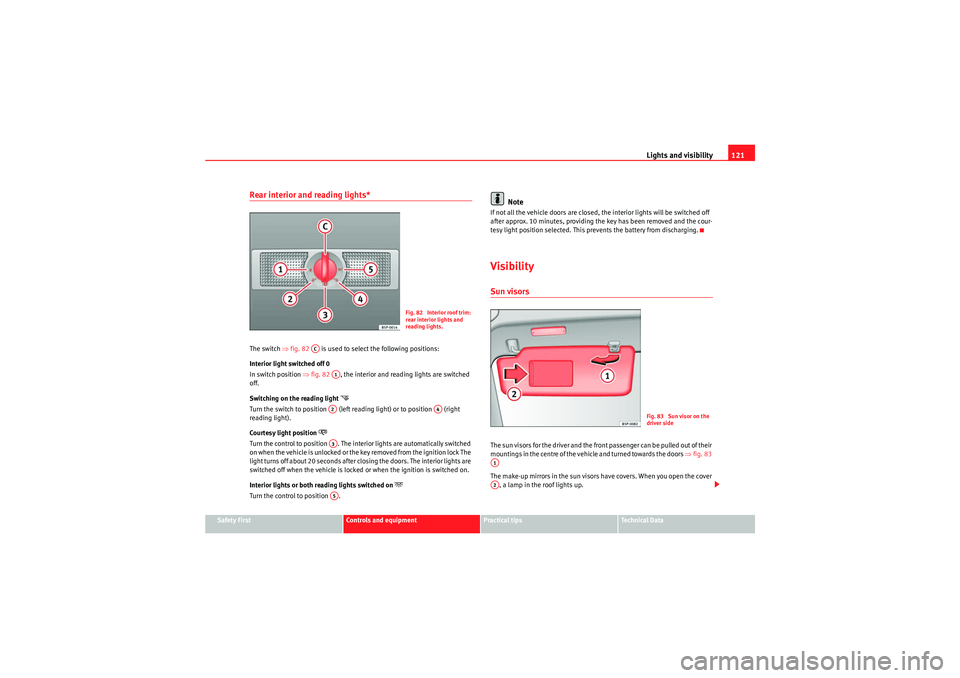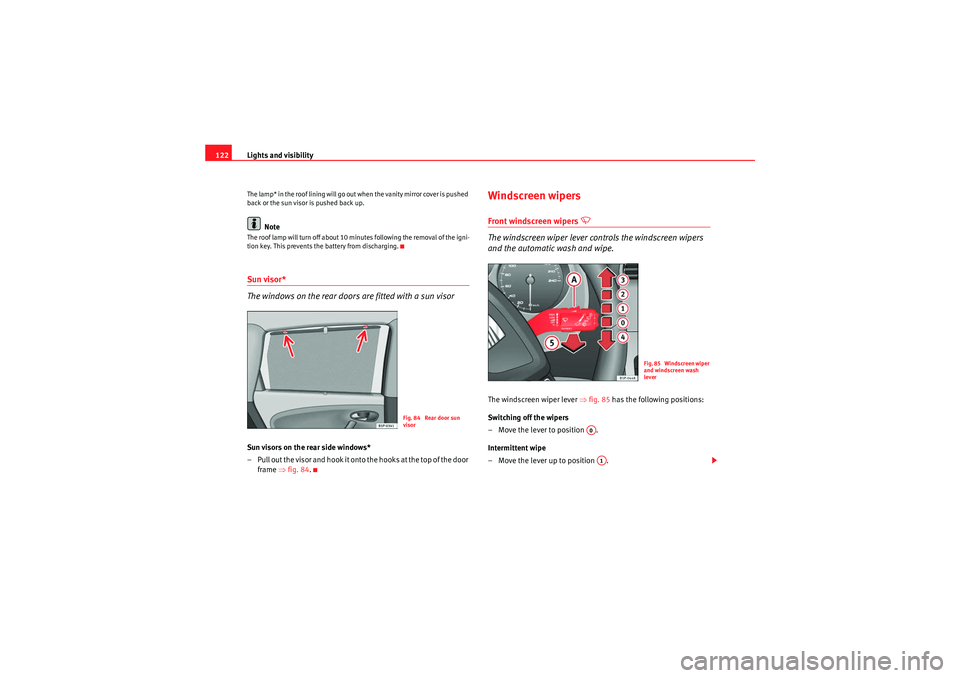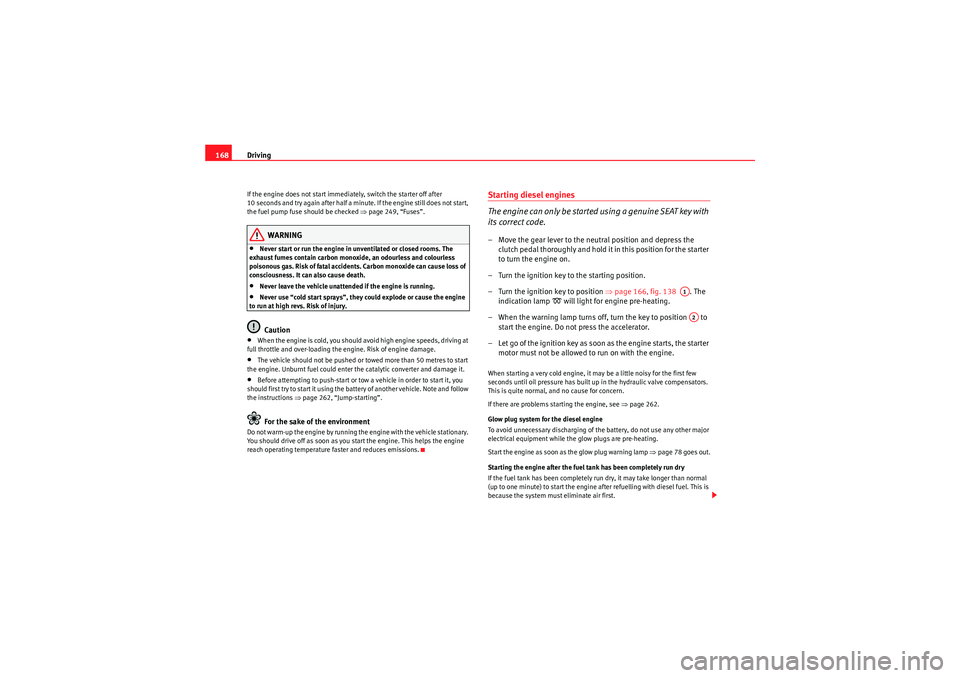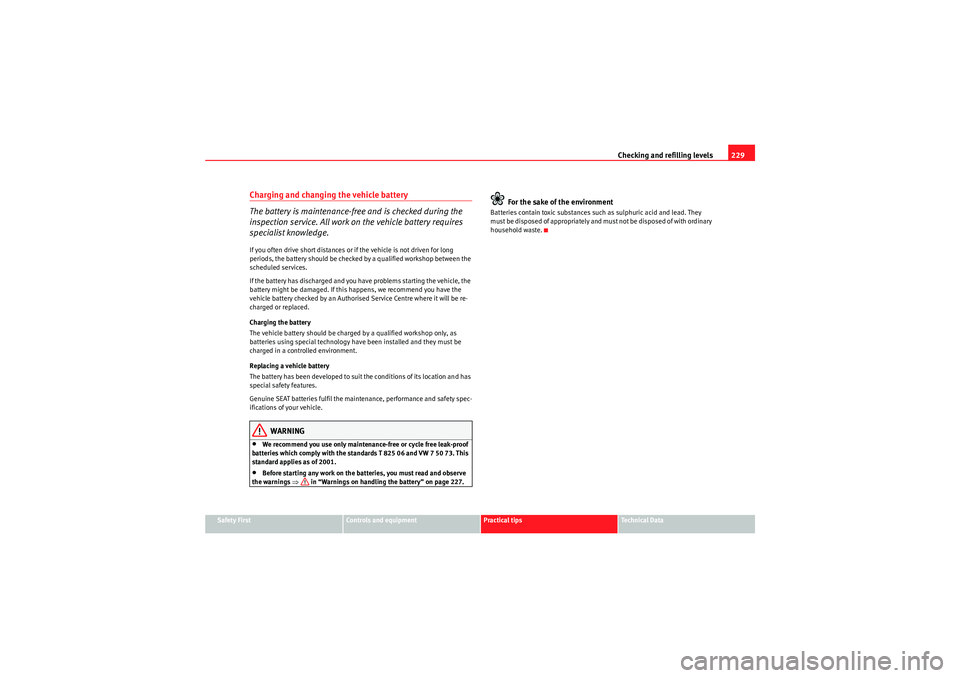charging Seat Altea Freetrack 2010 Owner's Manual
[x] Cancel search | Manufacturer: SEAT, Model Year: 2010, Model line: Altea Freetrack, Model: Seat Altea Freetrack 2010Pages: 294, PDF Size: 7.71 MB
Page 82 of 294

Cockpit
80wheels to lock quickly when you brake. This could cause the rear to break
away. Risk of skidding. Stop the vehicle and seek technical assistance.Washer fluid
This warning lamp lights up to indicate that the windscreen
washer level is too low.This serves as a reminder to fill up the reservoir at the earliest opportunity
⇒ page 222
The following message is shown on the dash panel display*
11): REFILL
WINDSCREEN WASHER FLUID .
Alternator
This warning lamp signals a fault in the alternator.
The warning lamp
lights up when the ignition is switched on. It should go
out when the engine has started running.
If the warning lamp lights up while driving, the alternator is no longer
charging the battery. You should immediately drive to the nearest qualified
workshop.
You should avoid using electrical equipment that is not absolutely necessary
because this will drain the battery.
Tyre pressure
The tyre pressure control system controls the tyre speed and
the frequency spectrum of each tyre.The tyre monitor
12) compares wheel revolutions and with this information,
the diameter of each wheel using the ESP sensors. If the diameter of a wheel
changes, the tyre monitor indicator lights . The wheel diameter changes
when:
•Tyre pressure is insufficient.•The tyre structure is damaged.•The vehicle is unbalanced because of a load.•The wheels of one axle are under more pressure (for example, driving with
a trailer or on extreme slopes).•The vehicle is fitted with snow chains.•The emergency wheel is fitted.
11)Depending on the version of the model.WARNING (continued)
12)Depending on the model version
Fig. 49 Centre console:
tyre monitor system
button
Freetrack_EN.book Seite 80 Donnerstag, 10. September 2009 10:33 10
Page 121 of 294

Lights and visibility119
Safety First
Controls and equipment
Practical tips
Technical Data
Interior lightsFront interior light type 1The switch ⇒fig. 78 is used to select the following positions:
Courtesy light position
Rocker switch in flat position (not activated). The interior lights are automat-
ically switched on when the vehicle is unlocked or the key removed from the
ignition lock And turn off approx. 20 seconds after closing the doors. The inte-
rior lights are switched off when the vehicle is locked or when the ignition is
switched on.
Interior light switched on
Push the switch to the position
.
Interior light switched off O
Push the switch to position O ⇒fig. 78.
Note
If not all the vehicle doors are closed, the interior lights will be switched off
after approx. 10 minutes, providing the key has been removed and the cour-
tesy light position selected. This prevents the battery from discharging.Front interior light type 2The switch ⇒fig. 79 is used to select the following positions:
Courtesy light position
Rocker switch in flat position (not activated). The interior lights are automat-
ically switched on when the vehicle is unlocked or the key removed from the
ignition lock And turn off approx. 20 seconds after closing the doors. The inte-
rior lights are switched off when the vehicle is locked or when the ignition is
switched on.
Fig. 78 Interior roof trim:
front interior lights
AA
Fig. 79 Interior roof trim:
front interior lights
AA
Freetrack_EN.book Seite 119 Donnerstag, 10. September 2009 10:33 10
Page 122 of 294

Lights and visibility
120Interior light switched on
Push the switch to the position
.
Interior light switched off O
Push the switch to position O ⇒page 119, fig. 79 .
Note
If not all the vehicle doors are closed, the interior lights will be switched off
after approx. 10 minutes, providing the key has been removed and the cour-
tesy light position selected. This prevents the battery from discharging.Front reading lights
Switching on the reading light
Press the corresponding button ⇒fig. 80 and ⇒fig. 81 to switch on
the reading light.
Switching the reading lights off
Press the corresponding button to switch the reading light off.
Fig. 80 Interior roof trim:
front reading lights, type
1
Fig. 81 Interior roof trim:
front reading lights, type
2
AB
AB
Freetrack_EN.book Seite 120 Donnerstag, 10. September 2009 10:33 10
Page 123 of 294

Lights and visibility121
Safety First
Controls and equipment
Practical tips
Technical Data
Rear interior and reading lights* The switch ⇒fig. 82 is used to select the following positions:
Interior light switched off 0
In switch position ⇒ fig. 82 , the interior and reading lights are switched
off.
Switching on the reading light
Turn the switch to position (left reading light) or to position (right
reading light).
Courtesy light position
Turn the control to position . The interior lights are automatically switched
on when the vehicle is unlocked or the key removed from the ignition lock The
light turns off about 20 seconds after closing the doors. The interior lights are
switched off when the vehicle is locked or when the ignition is switched on.
Interior lights or both reading lights switched on
Turn the control to position .
Note
If not all the vehicle doors are closed, the interior lights will be switched off
after approx. 10 minutes, providing the key has been removed and the cour-
tesy light position selected. This prevents the battery from discharging.VisibilitySun visorsThe sun visors for the driver and the front passenger can be pulled out of their
mountings in the centre of the vehicle and turned towards the doors ⇒fig. 83
The make-up mirrors in the sun visors have covers. When you open the cover , a lamp in the roof lights up.
Fig. 82 Interior roof trim:
rear interior lights and
reading lights.
AC
A1A2
A4
A3A5
Fig. 83 Sun visor on the
driver side
A1A2
Freetrack_EN.book Seite 121 Donnerstag, 10. September 2009 10:33 10
Page 124 of 294

Lights and visibility
122The lamp* in the roof lining will go out when the vanity mirror cover is pushed
back or the sun visor is pushed back up.
Note
The roof lamp will turn off about 10 mi nutes following the removal of the igni-
tion key. This prevents the battery from discharging.Sun visor*
The windows on the rear doors are fitted with a sun visorSun visors on the rear side windows*
– Pull out the visor and hook it onto the hooks at the top of the door frame ⇒fig. 84 .
Windscreen wipersFront windscreen wipers
The windscreen wiper lever controls the windscreen wipers
and the automatic wash and wipe.
The windscreen wiper lever ⇒fig. 85 has the following positions:
Switching off the wipers
– Move the lever to position .
Intermittent wipe
– Move the lever up to position .
Fig. 84 Rear door sun
visor
Fig. 85 Windscreen wiper
and windscreen wash
lever
A0A1
Freetrack_EN.book Seite 122 Donnerstag, 10. September 2009 10:33 10
Page 170 of 294

Driving
168If the engine does not start immediately, switch the starter off after
10 seconds and try again after half a minute. If the engine still does not start,
the fuel pump fuse should be checked ⇒page 249, “Fuses”.
WARNING
•Never start or run the engine in un ventilated or closed rooms. The
exhaust fumes contain carbon monoxide, an odourless and colourless
poisonous gas. Risk of fatal accidents. Carbon monoxide can cause loss of
consciousness. It can also cause death.•Never leave the vehicle unattended if the engine is running.•Never use “cold start sprays”, they could explode or cause the engine
to run at high revs. Risk of injury.Caution
•When the engine is cold, you should avoid high engine speeds, driving at
full throttle and over-loading the engine. Risk of engine damage.•The vehicle should not be pushed or towed more than 50 metres to start
the engine. Unburnt fuel could enter the catalytic converter and damage it.•Before attempting to push-start or tow a vehicle in order to start it, you
should first try to start it using the battery of another vehicle. Note and follow
the instructions ⇒page 262, “Jump-starting”.For the sake of the environment
Do not warm-up the engine by running the engine with the vehicle stationary.
You should drive off as soon as you start the engine. This helps the engine
reach operating temperature faster and reduces emissions.
Starting diesel engines
The engine can only be started using a genuine SEAT key with
its correct code.– Move the gear lever to the neutral position and depress the
clutch pedal thoroughly and hold it in this position for the starter
to turn the engine on.
– Turn the ignition key to the starting position.
– Turn the ignition key to position ⇒page 166, fig. 138 . The
indication lamp
will light for engine pre-heating.
– When the warning lamp turns off, turn the key to position to
start the engine. Do not press the accelerator.
– Let go of the ignition key as soon as the engine starts, the starter motor must not be allowed to run on with the engine.
When starting a very cold engine, it may be a little noisy for the first few
seconds until oil pressure has built up in the hydraulic valve compensators.
This is quite normal, and no cause for concern.
If there are problems starting the engine, see ⇒page 262.
Glow plug system for the diesel engine
To avoid unnecessary discharging of the battery, do not use any other major
electrical equipment while the glow plugs are pre-heating.
Start the engine as soon as the glow plug warning lamp ⇒page 78 goes out.
Starting the engine after the fuel tank has been completely run dry
If the fuel tank has been completely run dry, it may take longer than normal
(up to one minute) to start the engine after refuelling with diesel fuel. This is
because the system must eliminate air first.
A1A2
Freetrack_EN.book Seite 168 Donnerstag, 10. September 2009 10:33 10
Page 231 of 294

Checking and refilling levels229
Safety First
Controls and equipment
Practical tips
Technical Data
Charging and changing the vehicle battery
The battery is maintenance-free and is checked during the
inspection service. All work on the vehicle battery requires
specialist knowledge.If you often drive short distances or if the vehicle is not driven for long
periods, the battery should be checked by a qualified workshop between the
scheduled services.
If the battery has discharged and you have problems starting the vehicle, the
battery might be damaged. If this happens, we recommend you have the
vehicle battery checked by an Authorised Service Centre where it will be re-
charged or replaced.
Charging the battery
The vehicle battery should be charged by a qualified workshop only, as
batteries using special technology have been installed and they must be
charged in a controlled environment.
Replacing a vehicle battery
The battery has been developed to suit the conditions of its location and has
special safety features.
Genuine SEAT batteries fulfil the maintenance, performance and safety spec-
ifications of your vehicle.
WARNING
•We recommend you use only maintenance-free or cycle free leak-proof
batteries which comply with the standards T 825 06 and VW 7 50 73. This
standard applies as of 2001.•Before starting any work on the batteries, you must read and observe
the warnings ⇒ in “Warnings on handling the battery” on page 227.
For the sake of the environment
Batteries contain toxic substances such as sulphuric acid and lead. They
m ust b e d isp os ed o f a ppro p ria tely and m ust not be d isp ose d of wi th o rd ina r y
household waste.
Freetrack_EN.book Seite 229 Donnerstag, 10. September 2009 10:33 10
Page 285 of 294

Index283
Index
AABS . . . . . . . . . . . . . . . . . . . . . . . . . . . . . . . . . . . 184
Warning lamp . . . . . . . . . . . . . . . . . . . . . . . . . 79
Accessories . . . . . . . . . . . . . . . . . . . . . . . . . . . . 208
Acoustic signal . . . . . . . . . . . . . . . . . . . . . . . . . . 19
Acoustic warning . . . . . . . . . . . . . . . . . . . . . . . . 166
Adaptive headlights . . . . . . . . . . . . . . . . . . . . . 115
Adjusting the seat belt height . . . . . . . . . . . . . . 27
AFS (curve lights) . . . . . . . . . . . . . . . . . . . . . . . . 116
Air conditioner* 2C-Climatronic* . . . . . . . . . . . . . . . . . . . . . . 158
Air conditioning system General notes . . . . . . . . . . . . . . . . . . . . . . . . 162
Air conditioning* . . . . . . . . . . . . . . . . . . . . . . . . 154
Air recirculation mode 2C-Climatronic . . . . . . . . . . . . . . . . . . . . . . . 162
Manual air conditioning . . . . . . . . . . . . . . . 156
Airbag covers . . . . . . . . . . . . . . . . . . . . . . . . . . . . 36
Airbag system . . . . . . . . . . . . . . . . . . . . . . . . . . . 30 Curtain airbags . . . . . . . . . . . . . . . . . . . . . . . 41
Front airbags . . . . . . . . . . . . . . . . . . . . . . . . . 34
Side airbags . . . . . . . . . . . . . . . . . . . . . . . . . . 37
Warning lamp . . . . . . . . . . . . . . . . . . . . . . . . . 31
Alarm system Switching off . . . . . . . . . . . . . . . . . . . . . . . . 102
Alternator Warning lamp . . . . . . . . . . . . . . . . . . . . . . . . . 80 Ambient temperature display . . . . . . . . . . . . 64, 71
Anti-freeze . . . . . . . . . . . . . . . . . . . . . . . . . . . . . 220
Anti-lock brake system . . . . . . . . . . . . . . . . . . . 184
Warning lamp . . . . . . . . . . . . . . . . . . . . . . . . . 79
Anti-puncture tyres . . . . . . . . . . . . . . . . . . . . . . 233
Anti-theft alarm system . . . . . . . . . . . . . . . . . . . 102 Switching off . . . . . . . . . . . . . . . . . . . . . . . . 102
Anti-theft wheel bolts . . . . . . . . . . . . . . . . . . . . 242
Aquaplaning . . . . . . . . . . . . . . . . . . . . . . . . . . . 233
Ashtray* . . . . . . . . . . . . . . . . . . . . . . . . . . . . . . . 145
Automatic anti-dazzle interior mirror* Activating the anti-dazzle function . . . . . . 126
Deactivating anti-dazzle function . . . . . . . . 126
Automatic car wash tunnel . . . . . . . . . . . . . . . . 200
Automatic gearbox Kick-down feature . . . . . . . . . . . . . . . . . . . . 175
Automatic gearbox / DSG automatic gearbox . 171
Automatic lighting . . . . . . . . . . . . . . . . . . . . . . . 112
Automatic mode 2C-Climatronic . . . . . . . . . . . . . . . . . . . . . . . 160
Automatic wiper/wash function for the rear window 125
Auxiliary audio connection: AUX-IN . . . . . . . . . 147
BBall coupling . . . . . . . . . . . . . . . . . . . . . . . . . . . 196
BAS . . . . . . . . . . . . . . . . . . . . . . . . . . . . . . . . . . . 183 Battery
Changing . . . . . . . . . . . . . . . . . . . . . . . . . . . 229
Charging . . . . . . . . . . . . . . . . . . . . . . . . . . . . 229
Winter conditions . . . . . . . . . . . . . . . . . . . . 227
Belt tension device Disposal . . . . . . . . . . . . . . . . . . . . . . . . . . . . . 28
Warning lamp . . . . . . . . . . . . . . . . . . . . . . . . 31
Belt tension devices . . . . . . . . . . . . . . . . . . . . . . 28
Biodiesel . . . . . . . . . . . . . . . . . . . . . . . . . . . . . . 212
Biodiesel fuel . . . . . . . . . . . . . . . . . . . . . . . . . . . 212
Bonnet . . . . . . . . . . . . . . . . . . . . . . . . . . . . . . . . 215
Boot . . . . . . . . . . . . . . . . . . . . . . . . . . . . . . . . . . 149
Brake assist system . . . . . . . . . . . . . . . . . . . . . 183
Brake fluid . . . . . . . . . . . . . . . . . . . . . . . . . . . . . 226 Changing . . . . . . . . . . . . . . . . . . . . . . . . . . . 226
Warning lamp . . . . . . . . . . . . . . . . . . . . . . . . 65
Brake pads . . . . . . . . . . . . . . . . . . . . . . . . . . . . . 190
Brake servo . . . . . . . . . . . . . . . . . . . . . . . 183, 190
Brake system . . . . . . . . . . . . . . . . . . . . . . . . . . . 226 Brake servo . . . . . . . . . . . . . . . . . . . . . . . . . 188
Brakes . . . . . . . . . . . . . . . . . . . . . . . . . . . . . 188
Warning lamp . . . . . . . . . . . . . . . . . . . . . . . . 81
Brakes . . . . . . . . . . . . . . . . . . . . . . . . . . . . . . . . 190
Braking distance . . . . . . . . . . . . . . . . . . . . . . . . 190
Bulb changes general notes . . . . . . . . . . . . . . . . . . . . . . . . 253
Bulb defect warning lamp . . . . . . . . . . . . . . . . . . . . . . . . . 81
Freetrack_EN.book Seite 283 Donnerstag, 10. September 2009 10:33 10